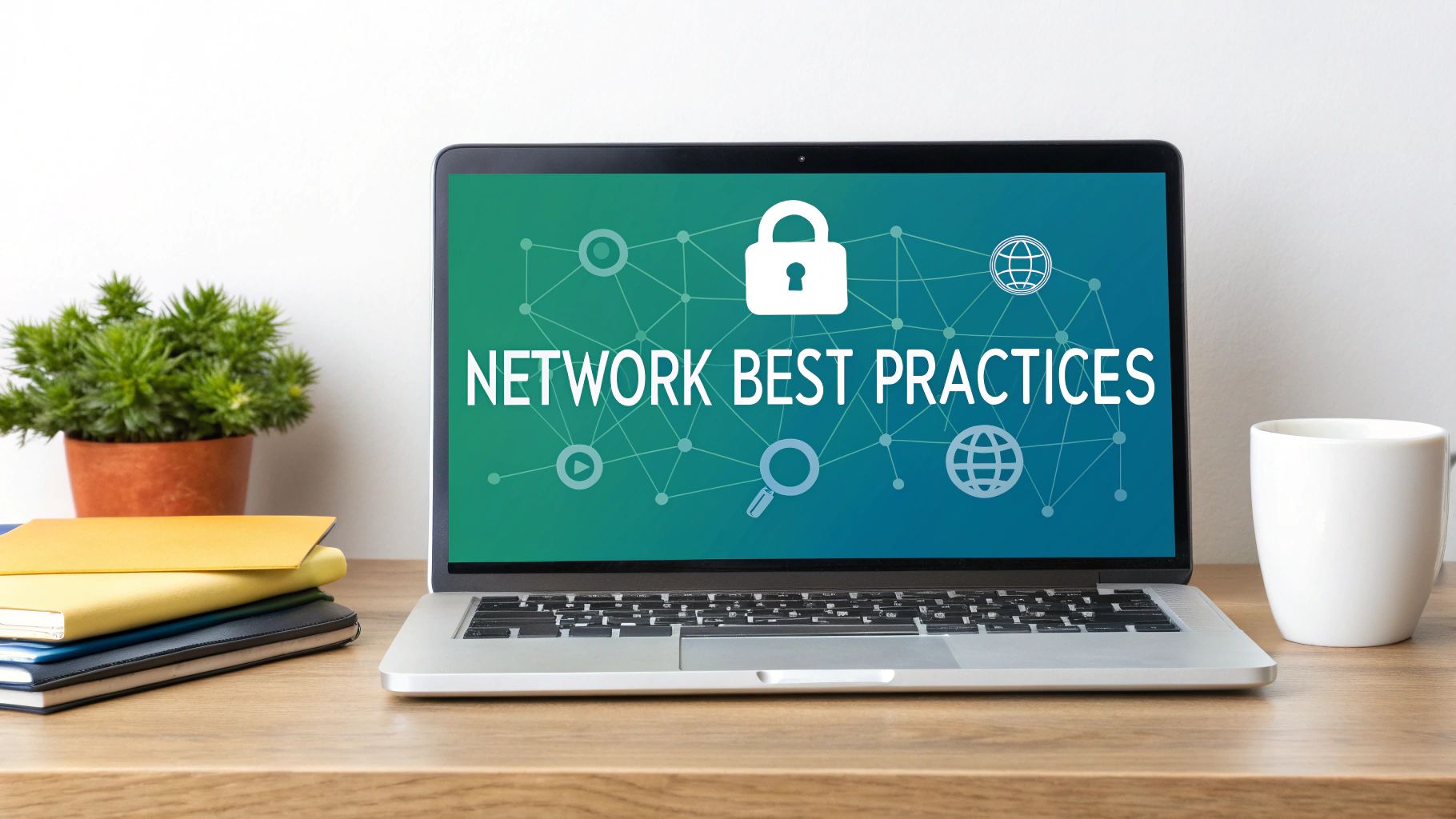Hey, have you ever been asked for a "network key" and felt a little fuzzy on what that actually means? Don't worry, it's a super common question, and the answer is way simpler than you might think.
You're right, it's basically just another name for your WiFi password. Think of it as the digital key to your online home; it's the secret code that unlocks the door to the internet while keeping unwelcome guests out.
Your WiFi Network Key Explained
This crucial password goes by a bunch of names—WiFi password, passphrase, or Pre-Shared Key (PSK)—but its job is always the same: to protect your connection. This wasn't always the case, though. Early wireless protocols were notoriously insecure, which led to the development of stronger standards like WPA and WPA2 that made these secret keys mandatory. You can get the full story on the history of Wi-Fi security on GetVoip.com.
Think of a basic network key like a single master key for an entire apartment building. It works, but if that one key gets lost or copied, the whole building is suddenly at risk. This is why modern network security has moved on.
In busy places like schools, retail stores, or offices with a bring-your-own-device (BYOD) policy, a single shared password is a huge security headache. That's where more advanced Authentication Solutions, often powered by industry leaders like Cisco and Meraki, come into the picture.
They use cool technologies like Captive Portals and IPSK (Identity Pre-Shared Key), sometimes called EasyPSK, to ditch the "one password for everyone" model. Instead, each user or device gets its own unique, managed credentials. This makes for a much safer and more easily controlled network, especially in the Education, Retail, and Corporate sectors. Exploring the different types of security keys for WiFi really shows how far we've come from that simple shared password.
Common Names for Your WiFi Network Key
It's easy to get confused when you hear so many different terms for the same thing. This quick reference table should help you recognize your network key, no matter what it's called.
| Common Term | What It Means | Where You'll See It |
|---|---|---|
| WiFi Password | The most common, everyday term. | Asking a friend for their WiFi, setting up a home router. |
| Network Key | A slightly more technical term, often used by devices. | On your computer or phone when it prompts you to connect. |
| Passphrase | Emphasizes it's a phrase, not just a single word. | In router settings or security documentation. |
| Pre-Shared Key (PSK) | A technical term for a password shared with all users. | In the security settings for WPA/WPA2 on your router. |
| WPA2 Password | Refers to the password for a network using the WPA2 protocol. | On the sticker on the bottom of your internet router. |
Hopefully, this clears things up! While the names might change, the function remains the same—keeping your connection secure.
The Evolution of WiFi Security Protocols
The network key you type in today is a world away from the simple, flimsy passwords of Wi-Fi's early days. The story of wireless security is really a cat-and-mouse game, constantly evolving from easily cracked codes to the robust standards that keep our information safe now.
It all began with WEP, which stands for Wired Equivalent Privacy. Think of it as the first draft of Wi-Fi security. It was a decent starting point, but its flaws were quickly exposed. WEP relied on a single, static key that hackers could often crack in minutes, leaving the entire network vulnerable. It became obvious that something much stronger was needed.
The Rise of Modern Standards
The glaring holes in WEP pushed the industry to create a tougher solution. The breakthrough came in 2004 with the IEEE 802.11i standard, which laid the groundwork for the powerful security protocols we use today. This standard made strong cryptographic keys—what we now commonly call a network key—a mandatory part of connecting to a wireless network.
The impact was immediate and massive. With real security in place, Wi-Fi certified devices skyrocketed from 100 million chipsets sold in 2005 to billions just a decade later. This explosive growth shows just how critical a secure network key is for building trust. You can dive deeper into the history of Wi-Fi on Wikipedia.
This infographic gives you a quick visual timeline of these key security milestones.
As you can see, the technology moved fast, quickly replacing weak standards with far more secure protocols to keep up with new threats.
This evolution gave us the security workhorses we rely on today:
- WPA (Wi-Fi Protected Access): The direct replacement for WEP, offering a much-needed security boost.
- WPA2: For years, this was the gold standard. It introduced even stronger encryption and became the default for most networks.
- WPA3: The latest and greatest protocol, built from the ground up to defend against modern hacking techniques. To get the full picture, check out our guide on what WPA3 is and why it matters.
Companies like Cisco and Meraki have been instrumental in driving these security improvements. They’re still pushing the envelope with advanced Authentication Solutions like IPSK (sometimes called EasyPSK) and Captive Portals. These tools are now essential for securing networks in demanding environments like Education, Retail, and corporate offices with BYOD policies.
Moving Beyond a Single Shared Password
So, what happens when one password for everyone just isn't cutting it anymore? This is a huge challenge in busy places like a school, a retail store, or any office with a Bring Your Own Device (BYOD) policy. Relying on a single shared network key is a major risk—if just one person leaks it, the entire network is suddenly vulnerable.
This is exactly why modern Authentication Solutions are moving past the traditional Pre-Shared Key (PSK). Instead of one master key for all, imagine giving every student, employee, or device its own unique key to the network.
The Power of Individual Keys
This more secure method is called Identity Pre-Shared Key (IPSK), sometimes also known as EasyPSK. It's a genuine game-changer for network security, especially in complex environments managed by platforms like Cisco Meraki.
The idea is simple but incredibly effective:
- One User, One Key: Every person gets their own private key to get online.
- Simple Revocation: If an employee leaves or a student loses their device, you just disable that one key.
- No More Chaos: You completely avoid the nightmare of changing the password for the whole organization and then having to update every single device.
This approach makes managing network access so much simpler. Grasping the importance of strong password policies is the first step, and for many organizations, IPSK is the logical next one.
This shift to individual credentials is a direct response to the glaring limitations of older systems. The industry-wide move towards stronger network keys, like those used in WPA2 and WPA3, has already had a massive global impact on security.
In fact, with the arrival of Wi-Fi 6, network keys evolved from static shared passwords to more dynamic, individualized encryption keys. This single change boosted security for over 4 billion Wi-Fi devices worldwide by 2020. These advanced Authentication Solutions, often working alongside Captive Portals, are essential for modern security in the Education and BYOD Corporate sectors.
For a deeper dive, it's worth seeing how IPSK works with RADIUS authentication to create a truly robust and scalable system.
How Captive Portals Create Secure Guest Access
Ever connected to the Wi-Fi at a hotel, airport, or your favorite coffee shop? You've probably seen that special login page that pops up before you can start browsing. That branded gateway is a Captive Portal, and it’s a brilliant way for businesses to manage who gets onto their network.
Instead of handing out a single Wi-Fi password to every customer who walks in, a captive portal acts like a friendly doorman. It presents a simple webpage where you might accept the terms of service, enter your email, or use a temporary code to get online. This is a go-to strategy for businesses in Retail and hospitality.
Separating Guests from Staff
The real magic of a captive portal is all about security. It allows a business to create a completely separate network just for guests. This keeps all the customer traffic safely isolated from the core internal network that runs sensitive things like payment systems and employee computers.
This separation is non-negotiable for modern businesses. It means that even with dozens of guests connected, the primary business operations remain secure and untouched. Networking hardware from leading names like Cisco and Meraki is built to handle this kind of network segmentation effortlessly, which is why it's such a popular solution.
By gating access through a login page, businesses control who gets on their network and under what conditions. This is a massive step up from a single, shared password that could be easily passed around or compromised.
This approach also pairs perfectly with more advanced Authentication Solutions. For instance, a captive portal can serve as the front door for an IPSK system (sometimes called EasyPSK). A hotel guest might enter a unique code from their room key, and the system instantly generates a temporary, individual network key just for their device.
This grants controlled access for a set period without ever exposing the main network’s password. To see how this technology is changing guest Wi-Fi, you can learn more about the functionality of a modern WiFi captive portal and see how it secures connections for all kinds of visitors.
Here’s a look at how different industries put these security concepts to work. A single password for everyone just doesn't cut it when you need serious control and a smooth user experience. Let's see how different sectors handle network access with modern solutions.
Smart Security for Education
Think about a university campus in the Education sector. You've got thousands of students, faculty, and staff, each with phones, laptops, and tablets. Handing out one password for the entire campus would be a security disaster. This is where a clever solution called IPSK (Identity Pre-Shared Key) comes into play.
With IPSK, sometimes called EasyPSK, every single user gets their own unique network key tied directly to their identity. If a student graduates or an employee leaves, an admin can simply deactivate their key in an instant. This doesn't affect anyone else on the network, making it a brilliant way to maintain a secure learning environment across a sea of devices.
Engaging Customers in Retail
Retail stores have a different puzzle to solve. They want to offer free guest Wi-Fi to shoppers but need to lock down their own network for things like payment systems and inventory scanners. The common setup here is a dual-network approach: one for guests, and one for staff.
Customers connect to the guest Wi-Fi and land on a Captive Portal—that branded login page you've probably seen a hundred times. It's a great marketing tool for collecting emails or pushing promotions. Behind the scenes, the store's critical operations are humming along on a completely separate, secure network protected by a strong WPA2 key.
This two-network strategy is the perfect way to balance public convenience with private security. Retailers can engage with customers without ever putting sensitive corporate data at risk.
Flexibility in the Corporate World
The modern workplace is all about BYOD (Bring Your Own Device). In the Corporate sector, companies have to let employees connect their personal phones and laptops to the network without compromising security. This is where powerful Authentication Solutions, like those from Cisco Meraki, are indispensable.
By adopting an IPSK model, each employee gets individual credentials for their personal devices. This way, every single connection is authorized and accounted for, which is crucial for protecting company data while giving employees the flexibility they need. It completely sidesteps the security holes of a shared password and makes managing a fleet of different devices a straightforward task.
WiFi Authentication Methods by Industry
Different industries face unique security challenges, leading them to adopt different network authentication strategies. The table below shows how sectors like healthcare, hospitality, and finance tailor their Wi-Fi security to fit their specific operational needs.
| Sector | Primary Challenge | Common Solution | Key Benefit |
|---|---|---|---|
| Healthcare | Protecting patient data (HIPAA compliance) & securing medical devices. | WPA2-Enterprise with 802.1X, often with MAC-based access for IoT devices. | Strong encryption and individual user authentication for strict data privacy. |
| Hospitality | Providing seamless guest access while securing internal operations. | Tiered guest networks with a Captive Portal; separate, secured staff network. | Enhanced guest experience and marketing opportunities without compromising security. |
| Finance | Securing highly sensitive financial data against sophisticated threats. | Multi-factor authentication (MFA) and WPA3-Enterprise. | The highest level of security, ensuring data integrity and preventing unauthorized access. |
Ultimately, the goal is the same across the board: provide the right level of access to the right people while keeping sensitive information locked down. The specific tools and methods just change depending on the job at hand.
Best Practices for Strong WiFi Security
Knowing what a WiFi network key is is one thing, but putting that knowledge to work is what really counts. For any organization, the single most important security upgrade you can make is moving beyond one password for everyone.
This is absolutely crucial in busy environments like Education, Retail, or any office with a BYOD (Bring Your Own Device) policy. Think about it—if that one shared password gets out, your entire network is wide open. That's why modern Authentication Solutions are no longer a luxury; they're a necessity.
Centralized Management and Segmentation
These days, solid network security is all about control and visibility. This is where tools like the Cisco Meraki dashboard really shine, giving administrators a single pane of glass to manage who gets on the network and what they can do.
The goal is straightforward: give people access only to what they absolutely need. Nothing more. That means walling off guest traffic from your internal company network and, ideally, giving every single user or device its own unique key.
Here are a few effective ways to do that:
- Network Segmentation: This is non-negotiable. Always set up a separate network for guests, which is often managed through a Captive Portal. This simple step keeps visitor traffic completely isolated from your sensitive internal data.
- Unique Keys for Everyone: Look into solutions like IPSK (which you might also see called EasyPSK). This technology lets you assign a unique network key to each person and device. The security benefit is huge because if one key is ever compromised, it only affects that one user, and you can revoke it in a heartbeat.
To really put your wireless network's defenses to the test, you might consider WiFi penetration testing to find and fix vulnerabilities. For more practical advice, check out our guide on the best practices for network security.
Still Have Questions? Let's Clear a Few Things Up
It's totally normal to have a few lingering questions about Wi-Fi network keys. They can seem a bit technical at first. Let's tackle some of the most common ones with simple, straightforward answers.
Where Can I Find My Wi-Fi Network Key?
For your home network, the easiest place to look is right on the router itself. Most routers have a sticker on the bottom or back with the default password, often labeled "WiFi Key," "Password," or "WPA Key."
Of course, if you've changed it since setting it up, you'll need to log into your router's administration page to find or change it. In a business setting, like in Retail or Education, you'll probably connect through a Captive Portal or an IT administrator will provide you with the credentials you need.
Is "Network Key" Just Another Name for a "WPA2 Key"?
Pretty much, yes. Think of "network key" as the everyday, catch-all term for your Wi-Fi password.
WPA2 (and the newer WPA3) are the specific security standards—the technical protocols—that actually use that password to lock down your network. So, a WPA2 key is just a network key that's being used on a network protected by the WPA2 standard. For the strongest security, you should always make sure your network is running on at least WPA2, or ideally, WPA3.
Can a Wi-Fi Network Have More Than One Key?
On a typical home network, the answer is no. Everyone uses the same single password, known as a Pre-Shared Key (PSK), to get online.
However, in more advanced setups, it's a different story. Authentication solutions from providers like Cisco Meraki can use a technology called IPSK (Identity Pre-Shared Key), which is sometimes branded as EasyPSK. This is a game-changer for security because it lets an IT admin create a unique, private network key for every single person or device. It’s a far more secure and manageable way to handle access in busy BYOD environments like offices, schools, and large public venues.
Ready to offer a secure, seamless Wi-Fi experience for your guests and staff? Splash Access provides powerful captive portal and authentication solutions that work with your Cisco Meraki hardware. Learn more and get started today at Splash Access.






